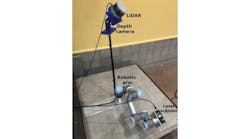Sam’s Club (Bentonville, AR, USA; www.samsclub.com) recently rolled out an inventory scanning technology, which is enclosed inside a heavy-gauge steel tower and installed on one side of an existing fleet of autonomous robotic floor scrubbers, the warehouse club announced in a news release.
The robots, floor scrubbing, and inventory sensing technologies are from Tennant Company (Eden Prairie, MN, USA; www.tennantco.com), which produces cleaning machines, tools, and supplies. Tennant, in turn, partners with Brain Corp (San Diego, CA, USA; www.braincorp.com), which has developed an AI platform, BrainOS, for operating autonomous robots. The company also provides the inventory scanning/analytics capabilities.
Sam’s Club, a division of Walmart Inc. (Bentonville, AR, USA; www.walmart.com), is the first deployment of the inventory scanning technology, which was launched in January 2022. Sam’s Club began testing the autonomous floor scrubbers in 2018, expanding their use to all clubs in 2019 and 2020. There are now almost 600 of the units at Sam’s Club locations.
Using digital image data and data analytics, the inventory sensing and management product provides Sam’s Club with information about product stock levels, product location on shelves, compliance with product placement plans, pricing accuracy, and whole-store maps. The goal is to better meet customers’ needs, so, for example, they are not confronted with products that are sold out or shelved in the wrong location.
Walmart Canada (Mississauga, ON, Canada; www.walmart.ca) also is investing in technology to improve product availability on store shelves. It opted to purchase a computer vision solution from Focal Systems (Burlingame, CA, USA; www.focal.systems).
In a report (bit.ly/3AqLDgm), McKinsey & Company (NY, NY, USA; www.mckinsey.com) says the push for automation among retailers is driven by margin pressures. The components of these existing systems include shelf-edge labels, self-checkout terminals, shelf scanning robots, and partial automation of backroom unloading, McKinsey explains.
At Sam’s Club, the decision to add the inventory sensing capability occurred during the rollout of the autonomous floor scrubbers. “After exploring several different solutions, we realized that retrofitting the scrubbers we were already testing provided the best, most consistent ability to deliver insights,” explains Todd Garner, VP, In-Club Product Management – Sam’s Club.
How It Works
The inventory scan tower captures data on product availability on store shelves as it moves autonomously around the club. “We scan the clubs daily. Today, we update locations within 24 hours. As we continue to evolve and deploy new capabilities, we will continue to move closer to real time updates,” Garner says.
The images of individual products or shelf sections are captured using high-definition cameras: one for upper shelves and two for eye-level shelves. Illumination is provided by LED. To help with object detection and avoidance and navigation, a LiDAR sensor inside the tower works with two LiDAR sensors and 3D machine vision sensors located on the autonomous robot.
“During scanning, the robot captures photos of individual SKUs and/or shelf sections. These individual images are localized using the machine’s sensor data and a combination of AI and machine learning to use them to develop item, features, and whole store maps indicating where specific items are within the store,” Brain Corp says on its Website.
The image data is transferred to an analytics application, which provides the insights on product availability. The information also is integrated into existing workflows, so store employees can receive to-do lists, such as which products to restock, on their mobile devices.






